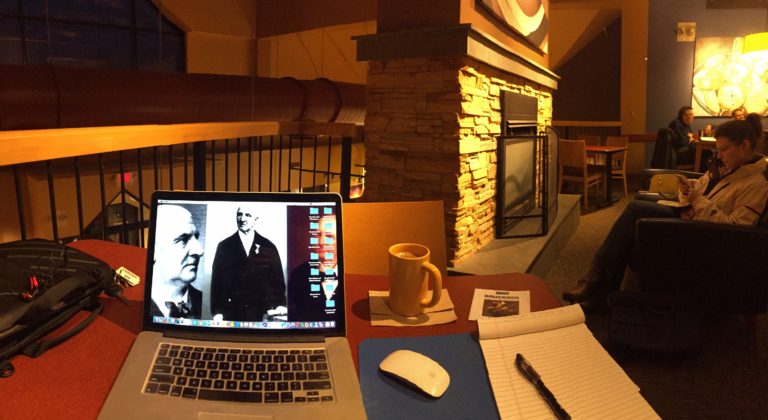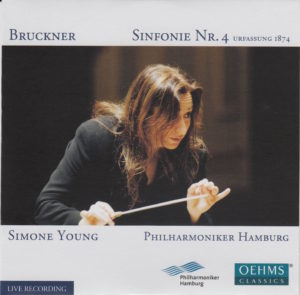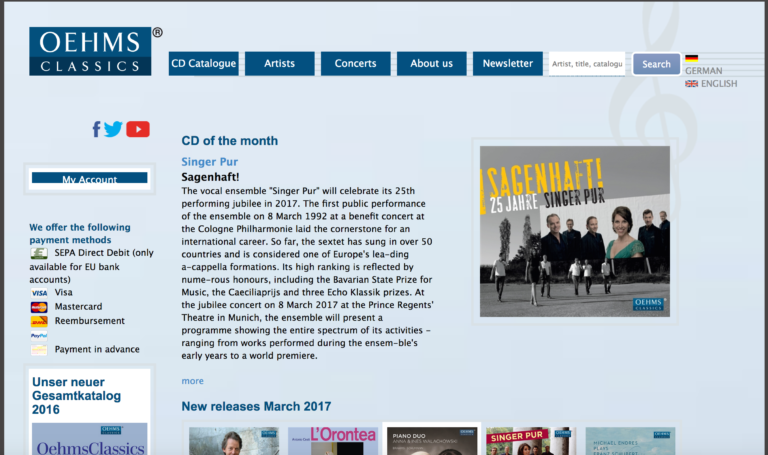
My “office” this morning is one of the last Panera Bread Company restaurants I’ll bother to visit.
It’s the only one that I’ve seen with an upstairs level, a second floor complete with fireplace and view overlooking the schlubs down below.
 This morning, I am listening to Anton Bruckner’s Symphony No. 4 in E Flat Major (WAB 104), nicknamed “Romantic,” interpreted by Australian conductor Simone Young (1961-).
This morning, I am listening to Anton Bruckner’s Symphony No. 4 in E Flat Major (WAB 104), nicknamed “Romantic,” interpreted by Australian conductor Simone Young (1961-).
Her orchestra is the Philharmoniker Hamburg.
I first encountered Maestro Young on this leg of my Bruckner journey on Day 5, Symphony No. 1.
Then again on Day 10, Symphony No. 2.
Then again, most recently, on Day 16, Symphony No. 3.
You can read what I thought of her interpretations by letting your mouse do the clicking.
Or not. Up to you.
Today is the fourth time I’m listening to a performance conducted by Ms. Young.
And with slightly different results.
But more about that later.
I previously wrote that I would not duplicate my bios of Ms. Young and her orchestra. But I feel I do have to provide the information about the CD booklet that pretends to serve as liner notes. In that slim volume, I read,
You will find detailed liner notes from Michael Lewis for all sinfonies via download on www.oehmsclassics.de
That’s all well and good.
But I paid $31.58 for this box set. And now I have to go to a web site to find liner notes?
What were the folks at OEHMS Classics thinking?
Especially when that URL goes to the home page of OEHMS Classics, and not a specific page that lists liner notes for this set and others. Without that dedicated URL (which is what I would have printed in the liner notes booklet had I been in charge of this box set), it’s anyone’s guess where the liner notes are on their site.
See what I mean:

Where are the liner notes?
Yoo-hoo? Liner notes!
Come out, come out, wherever you are!
How much time do I want to spend searching for liner notes that should have been in the box in the first place?
Zero.
That’s how much time.
But I clicked around for awhile until I found the link to the pdf of the liner notes. Here it is.
You’re welcome.
And, by the way, the pdf of liner notes – at 56 pages – is actually quite extensive. There’s some interesting stuff in there. I just wish it was included in the CD box set and/or given a unique URL to find them quickly and easily on the OEHMS web site.
Ah well. As Tony Soprano would say, “Whattayagonnado?”
Here’s an excerpt from the liner notes about Bruckner’s Fourth:
RADICAL APPROACHES TO EXPRESSION AND FORM
Remarks about the first version of
Anton Bruckner’s Symphony No. 4
in E-flat major (1874)The symphony in E-flat major, written in 1874, marks the peak of Bruckner’s creative period that lasted from 1872 to 1875; and is one of the most popular symphonies in music history. However, at the same time, the uncounted modifications and improvements the Maestro added almost manically also added up to previously unimaginable changes. While the situation is already almost inscrutable for the Symphony No. 3, we have to accept almost 10 different version numbers for the Symphony No. 4 in record catalogues and internet forums. It might there- fore make sense to get an overview first.
The version used for this recording is quite indisputably the most definite and obvious one in existence: it is the original, or ur-version written in 1874, the version that had to wait for more than 100 years to see its premiere.
These are quite good liner notes. It’s just a shame the record label didn’t choose to put them in the box set where they belong.
Here are the objective aspects of today’s recording:
 Bruckner’s Symphony No. 4 in E Flat Major (WAB 104), composed 1873-1874
Bruckner’s Symphony No. 4 in E Flat Major (WAB 104), composed 1873-1874
Simone Young conducts
Young used the “Urfassung 1874,” according to the back of the CD sleeve (“Urfassung” is German for “original version”)
Philharmoniker Hamburg plays
The symphony clocks in at 70:01 – Yikes! (this wins the coveted “Yikes!” award for length)
This was recorded in Hamburg, Germany, on December 1-3, 2007
Young was 46 when she conducted it
Bruckner was 50 when he finished composing it (the first time)
This recording was released on the OEHMS Classics label
Bruckner wrote his symphonies in four movements. The time breakdown of this one (Symphony No. 4 in E Flat Major), from this particular conductor (Young) and this particular orchestra (Philharmoniker Hamburg) is as follows:
I. Bewegt, nicht zu schnell……………………………………………………………………19:54
II. Andante, quasi allegretto…………………………………………………………………18:28
III. Scherzo. Bewegt (With motion) – Trio: Nicht zu schnell (Not too fast)……………………………………………………………………………………………………….12:45
IV. Finale: Bewegt, doch nicht zu schnell (With motion, but not too fast)……………………………………………………………………………………………………….18:53
Total running time: 70:01
Okay. Now, here are the subjective aspects of today’s recording:
My Rating:
Recording quality: 4
Overall musicianship: 4
CD liner notes: 2 (meager notes, confusing layout, essentially an “ad” for the Hamburg State Councillor of Culture and the Hamburg Philharmonic)
How does this make me feel: 4
This is actually quite good!
Something about Simone Young’s performance today spoke to me, from the opening horns of the first movement to the powerful and triumphant of the Finale, the last 2-3 minutes of which had me spellbound.
I heard things in this performance that I didn’t really before. For example, the “marching” quality in the first minute of the Andante (Movement II). And the riveting nature of the Finale.
I liked this!
I noted previously that Maestro Young is from the Lorin Maazel school of conducting – as in, “The longer I make this, the better it will be.” Perhaps she was paid by the minute?
Hers is, once again, the one of the longest performances of Bruckner’s Fourth of the seven conductors I heard on this leg of my journey. Celibidache still has her beat by a long shot. But topping 70 minutes puts her into the Yikes! category. Take a look:
Young, Day 24 – 71:01
Klemperer, Day 23 – 61:01
Janowski, Day 22 – 63:29
Inbal, Day 21 – 68:17
Furtwangler, Day 20 – 65:55
Celibidache, Day 19 – 79:11
Barenboim (Pink Box), Day 18 – Day 19 – 63:53
Barenboim (Blue Box), Day 17 – 68:23
I feel sorry for Maestro Young because she had to follow Marek Janowski and Otto Klemperer this time in my rotation of conductors. The exceptional, exceptional quality of the Janwoski box makes the Young box look like something I’d find beside the road. The sound quality of Janowski’s work is the highest possible. Absolutely top notch. And the box itself – liner notes and all? A work of art.
Even the Klemperer box beat Young’s, both in sound and in “magic.” (Plus, the damn thing actually has liner notes, meager as they are.)
So that may color how I feel about Simone Young’s performances, too. Following Janowski and Klemperer is no easy task.
And OEHMS Classics was not up to it.
Yet, today’s performance is one I can recommend to others.
Hard to believe, but…
Tomorrow starts a new cycle of symphonies and conductors interpreting Bruckner’s Fifth!
